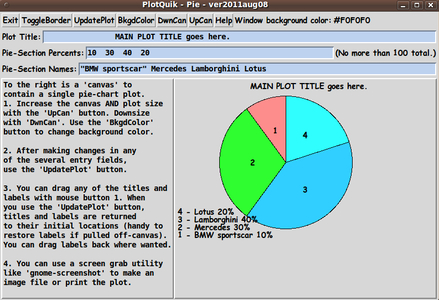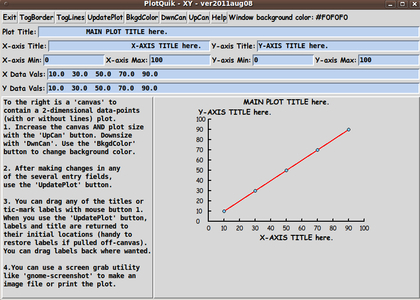|
'FE HandyTools' DOWNLOAD LINK
and Install Instructions :
The install file is a self-extracting shell script.
It would be nice if we could simply name it with a '.sh' suffix.
But it appears that most web browsers (or, actually, web servers) will
assume that it is an all-text file, when, in fact, it has a gzipped
tar file appended to the script portion of the file.
When a web browser asks for the file from the web server,
if the file has the '.sh' suffix, the file will be downloaded
in 'ascii' mode instead of 'binary' mode.
The binary data in the file (the gzipped tar stuff) gets corrupted.
Web servers usually require a suffix on the file in an HTML page link,
and the suffix is used by the web server to determine how to handle the file.
As a workaround, the '.sh' file is provided with a suffix of '.sh.exe'
--- in hopes that the web-browser/web-server combo will think the file is
a 'binary' file and download it in a 'binary' mode that does not corrupt the file.
This seems to work. The '.sh.exe' file downloaded fine for me, using the Seamonkey2
web browser on Ubuntu Linux --- on a little Acer netbook.

* feHandyTools *
|
Right click here, on this link to the '.sh.exe' file, and, in the popup
menu of your web browser, choose to save this self-extracting shell script
in a download directory on your machine.
(Your web browser will offer an option such as 'Save Link Target As ...'.)
For good measure (that is, as an alternative), the install file is also provided
with the suffix '.sh.tar'.
So if the '.sh.exe' file does not work for you
(say, the web-server/web-browser 'dance' tries to do
something 'funny' with files with a '.exe' suffix),
right click here, on the '.sh.tar' file link, and, in the popup menu of
your web browser, choose to save this self-extracting shell script
in a download directory on your machine.
To see the quick version of installing 'feHandyTools', go to the
SUMMARY section at the bottom of
this web page.
Go to the
FE Videos page to see the install
videos for the several FE subsystems.
The install procedure for each subsystem is similar ---
namely, prepare and run a self-extracting script, in 3 quick steps.
(There is no install video for 'feHandyTools', yet. See the install video
for 'feAppMenus'. The install procedure is the same for both systems.)
NOTE:
The '2011oct23' release of 'feHandyTools' is a 'partial' release
--- corresponding to a 0.7, say, release of systems using that kind of
release numbering system.
Aiming for a 'changeable' system :
The 'HandyTools' FE subsystem installation has been set up so that
the startup scripts of the many 'toolchests' within it
will automatically figure out the install directory from the
full name of the startup script being used to start these utilities.
This auto-setting of the install directory should work
even if one goes to an feHandyTools 'scripts' directory, in a terminal
window, and starts a script via a command like './feHandyTools' or
'./fe_plot_tools.sh'.
For example, this is useful when testing changes to the 'chestdef'
startup scripts --- or changes to the 'make_chest.tk' script that
those scripts call to make the GUI 'toolchests'.
In the terminal window, you will be able to see
programmer-supplied debug messages and shell interpreter
messages, including error messages that may be generated from changes
that you may make to the installation files.
I am trying to avoid having me (the installation files preparer)
or the user hardcode the install directory name (fully-qualified)
into the many possible startup scripts
--- especially since there could be 30 or more startup scripts in
the FE HandyTools subsystem.
Another advantage of this strategy is that the FE subsystem would
still work, even if the user renamed the install directory
(from 'feHandyTools_yyyymmmdd' to 'feHandyTools', say) or
moved the installation directories and files to another
location.
(The main requirement is that the SUB-directory structure of the
FE subsystem, and the subdirectory names and filenames, be preserved.)
The install steps, in detail :
Your home directory or the 'Desktop' directory of your home directory
will do, as the download directory. BUT ...
To keep an organized directory structure, you may find it better to
make a directory named 'DOWNLOADS', for example, in your Home directory.
Then save ALL your 'third party' application install files there,
from then on.
By 'third party', I mean applications that are NOT distributed
via a monolithic package management system of your Linux/Unix system
--- like the FE apps are not.
Seamonkey2 (a Mozilla.org web browser, son of Netscape)
is another example of such an app.
In mid-2010, it was not available in the 'Ubuntu Software Center'
nor via the
'Synaptic Package Manager'.
I downloaded the Seamonkey2 Linux install file from the
Seamonkey website into my $HOME/DOWNLOADS directory ---
and I installed it into a $HOME/apps directory that I created
for apps that I want to preserve during Linux upgrades.
I preserve the apps simply by not overlaying my home directory
(and backing up my home directory as a precaution).
I have also installed the SciTE text editor --- 'gscite' --- in my
$HOME/apps directory, in a 'gscite_2.27' subdirectory.
Similarly, the 'feHandyTools' subsystem will install into a subdirectory
of $HOME/apps.
Again, to see the quick version of installing the 'feHandyTools' subsystem,
go to the brief SUMMARY section
at the bottom of this web page. Installation details follow.
Preparing the downloaded
'.sh' install file for execution :
First, rename the file --- remove the '.exe' or '.tar' suffix.
If you are positioned at your download directory with the Nautilus
file manager, simply right click on the install file, choose 'Rename'
in the popup menu, and use the Backspace or Delete
key to remove the last 4 characters from the filename.
If you are in a terminal window, positioned at the download directory,
you can use the 'mv' (rename) Linux/Unix command in a form like this :
mv whatever.sh.exe whatever.sh
NOTE:
When you download the self-extracting script file to your file system,
it may lose its execute permissions. [This is a nice security
feature on some operating systems, making it harder for people to
run rogue programs on your computer.]
You can make sure the '.sh' file is executable as follows.
-
Navigate to it in the Nautilus file-manager ---
if you're not there already.
-
Right-click on it and choose 'Properties' at the bottom of
the Nautilus options window that pops up.
-
Go to the 'Permissions' panel on that 'Properties' window and make sure
the checkbox labelled 'Allow executing file as program' is turned on.
Altnernatively, in a terminal window, when you are positioned in the
directory in which you put the '.sh' install file, issue the 'chmod 755'
command on the filename of the self-extracting script.
The command format :
chmod 755 whatever.sh
Content of the '.sh' file :
While you are in that terminal window, you can check out the script
lines of the file by issuing the 'head -250' command against the
file.
You will see about 245 lines of script text (with lots of comment lines)
--- and then some gobbledy-gook characters in the terminal window.
That gobbledy-gook is the starting contents of the gzipped tar file that
contains the 'feHandyTools' installation files.
The self-extracting script is a combination of text lines and
binary data.
If you try to view the install script with a text editor, like
'gedit', it will not view the file, because the editor detects the
binary data and thinks it is dealing with a binary file.
The authors of 'gedit' do not allow you to try to display the file ---
partly because 'lines' in (some) binary data files are thousands
of bytes long.
As an interesting note (at least I think so), the FE 'xpg' utility is not
as finicky as 'gedit'.
If a binary file is not too large (in some sense or another),
'xpg' WILL show the binary file.
Of course, most of the bytes in the file show as gobbledy-gook characters
in the 'xpg' text area.
But you CAN read strings of human-readable text in the binary file.
In particular, you can use 'xpg' on the 'feHandyTools' self-extracting script
file.
It will bring that combined text-and-binary file up quickly with no
complaints (no error messages).
You can see the text of the script at the top of the file.
In fact, if you scroll down to the part of the file where the binary
data starts, the 'xpg' window should not complain or go bye-bye ---
even if you scroll to the bottom of that binary data.
Similarly, for some of the other FE self-extracting script files --- like
the ones for the 'FE Nautilus Scripts' releases, you should be able
to scroll through the entire self-extracting script file, with 'xpg'.
How to execute the '.sh' install script :
(a command-line method)
If you are still in a terminal, positioned at the download directory
that contains the self-extracting script file, say
after doing the 'head' command on the '.sh' file,
you could execute the '.sh' script right there via the command line.
(See a GUI mouse-click method, below.)
Enter a command of the form
./whatever.sh
That is, type a dot and slash, then type (or 'mouse-paste') the '.sh' filename
and press Enter.
You will see some output from the execution of the script, including
-
'mkdir' commands that make the 'feHandyTools_yyyymmmdd' install directory,
under $HOME/apps
-
the 'tail' command that is used to extract the gzipped tar file
from the '.sh' file --- putting the '.tgz' file in the '/tmp' directory
-
output of the 'file' command applied to the extracted file ---
confirming (hopefully) that the extracted file is indeed a
'gzip compressed data' file
-
the output of 'ls -l' on that extracted file --- to show
the number of bytes in that gzipped tar file
(It should be 4,906,874 bytes for the 2011oct23 file.)
-
the output of 'tar ztvf' on the extracted '.tgz' file --- to show the
'table of contents' of the extracted file
(The table of contents will simply be the directory names and
filenames that make up the installation --- along with some
file permissions information.)
-
a 'cd' command that sets up the 'working directory'
of the install script at the 'feHandyTools' install directory,
for execution of the following un-tar command
-
the output of 'tar zxvf' on the extracted '.tgz' file,
which gunzips the file into a tar file and then extracts the
contents of that tar file into the install directory
(The output of 'tar zxvf' will look a lot like the
'table of contents' output, the output of 'tar ztvf'
--- but without the file permissions info.)
(The 't' in the tar command stands for table of contents,
the 'x' for extract.)
-
the 'mkdir' commands that make a '.freedomenv' directory in your home
directory --- and a subdirectory named 'feHandyTools' under that directory
--- if they did not exist already.
-
two 'cp' commands that copy the 'set_FEDIR.shi' and 'set_feDIR.tki'
shell 'include' files from the installation directories 'includes_sh'
and 'includes_tk', respectively, to the '$HOME/.freedomenv/feHandyTools/'
directory.
(The 'set_FEDIR.shi' shell 'include' file is the code mentioned above,
that figures out the install directory from the name of the FE script
being called --- that name being available in the $0 variable of the
calling script. More than you wanted, or needed, to know, eh?)
(The 'set_feDIR.tki' Tk script 'include' file does a similar thing for
the '.tk' scripts of the FE subsystems.)
-
the 'mkdir' command that makes a 'bin' directory in the $HOME/apps
directory, if a 'bin' directory did not exist already
-
a link command ( 'ln' ) that makes a link from 'feHandyTools' in the 'bin'
directory to the 'feHandyTools' startup script in the
$HOME/apps/feHandyTools_yyyymmmdd/scripts
directory
Some of the many ways to implement that 'feHandyTools' startup script
are described further below.
An alternative to running the
install script by typing its name
in a terminal-shell window (namely,
a GUI mouse-click method) :
If you are positioned at the '.sh' install script (that is, positioned
in your download directory) with a GUI file manager like Nautilus,
you could double-click on the '.sh' file ---
after making sure that it has execute permission, as described above ---
and choose the option to 'Run in a terminal'.
You will see the messages described above appearing in the terminal
that pops up.
If the terminal window just flashes and does not stay open
(or the installation goes so fast that the terminal window
does not even flash), navigate to the '$HOME/apps' directory,
and see if the 'feHandyTools_yyyymmmdd' directory was created.
Check whether the 'scripts' subdirectory of that directory
was created, containing the 'feHandyTools' script.
And check the 'tkGUIs' subdirectory of the install directory,
which should contain the 'make_chest.tk' file.
If those directories and files exist,
then the installation probably went OK.
Where the application files 'land' :
(via a safer-than-most install strategy)
('root' permissions not required)
When the self-extracting shell script file executes, it automatically
puts a set of directories in a '$HOME/apps/feHandyTools_yyyymmmdd'
directory --- that is, under your home directory --- where yyyymmmdd
represents a release date.
Example: $HOME/apps/feHandyTools_2011oct23
Note that you do not have to change to 'root' to do the install.
In fact, I never like having to switch to 'root' to do an install.
When I have to supply the root password to do an install,
I am being put in the position of having to trust the people who
put the install package together that they are not going to use
that all powerful permission to do serious damage to the
root-owned directories and files on my machine.
And I am trusting that they are NOT going to install key-loggers or
Linux/Unix viruses/trojan-horses on my machine, hidden in that
massive directory structure.
Or, 'they' could install a 'hidden' program that
sends data to an organization (or person), over the Internet,
or do some other useless-to-me thing,
whenever their program is 'triggered', hidden among all those directories
(and when I have my connection to the Internet on).
[I, and my wife, have been a victim of these several things
on MS Windows. I now setup separate 'admin' and 'user' accounts on MS Windows,
similar to 'root' and 'user' on Linux/Unix. This, at least, makes one
aware of when a web page or email is trying to install a program unbeknownst
to the 'user' --- because an error message will appear when the 'user' does
not have 'admin' access to Windows system directories and ProgramFiles
directories, where viruses and trojan horses are typically installed.]
Do you hear that HP, Microsoft, Google, and a large number of other software
distributors? Cut the nonsense out!
At least prompt us, before taking liberties with our computers.
For example, let us decide whether we want your programs to start
up as part of our computer's boot up process.
Maybe we don't want your 'stuff' shoved in our faces every time
we log on --- or every time we start up an app in which your
personal-data-collecting stuff has been included as an intrusive plugin.
Furthermore, we do not like lots of ad-riddled games (and other
junk programs that most of us will never use) put on our computers.
(Hear that, Mozilla Firefox and Google and Yahoo??)
So rest easy. This install does not require you to open yourself to
damage like mangling of your root-owned directories --- or commandeering
of root-owned processes.
No 'root' access/permission/password is required.
And nothing is added to your computer's startup processes.
YOU are the one who decides when the 'feHandyTools' components are run.
For some simplicity, this install does not ask for an install directory.
The install script simply makes an 'apps' directory in your home directory,
if you do not have one.
And the install script makes a directory with a name of the form
'feHandyTools_yyyymmmdd' under the 'apps' directory.
Having apps like FE systems in your home directory can be a real boon at Linux
OS upgrade time.
If you follow the procedure of preserving your home directory
(as a separate disk partition) during a Linux OS upgrade,
then you do not have to re-install the FE 'HandyTools'
subsystem installation files, after your Linux upgrade.
Since these installation files are not in a system directory like '/usr',
they will not be wiped out in a Linux system upgrade.
And even if you allow the Linux OS upgrade to wipe out your home directory,
if you simply drag your '$HOME/apps' directory onto a USB stick (or some other
storage device) before the Linux upgrade, you can simply drag it back to
your home directory after the Linux upgrade is complete.
Size of the installation :
After installation, the 'feHandyTools' files occupy on the order of 15 Megabytes of
disk space.
The 2011oct23 self-extracting install script is 4,915,649 bytes in size.
About 98% of that is the compressed installation files (mostly scripts
and text files).
The installation files, after extraction from the compressed file
that was appended to the self-extracting install script,
expand to about 10 to 15 megabytes in size.
These are small sizes compared to applications like GIMP or
Firefox.
The installation would be a lot smaller, but I have included about 100
Tcl-Tk 'demo' scripts --- in the 'PROGRAMMINGtools' toolchest of
'feHandyTools'.
These scripts, when run, give an idea of the surprising
things that can be done with the Tcl-Tk scripting language.
And the code is handy to have as reference when looking for example code
to implement actions and GUI formats like those seen in running
the demo scripts.
I contend that you can get a lot of bang, for zero bucks, from this
relatively small set of small (script) files.
The sub-directories of
the FE 'HandyTools' install :
The install directories go under the 'feHandyTools_yyyymmmdd' directory ---
fullname
$HOME/apps/feHandyTools_yyyymmmdd.
It is a simple, 'almost-flat' directory structure --- only one level
of directories (except for the 'images' directory --- which contains a
'bullets' directory ; and except for the 'scripts' and 'tkGUIs' directories
which contain subdirectories corresponding to the toolchests --- AUDIOtools,
FILESlists, FINDlists, PLOTtools, SPACElists, TERMtools, ... ).
The sub-directory names are
-
chestdef_scripts
-
chestdefs
-
helps
-
images
(with a 'bullets' subdirectory)
-
includes_sh
-
includes_tk
-
lists
-
scripts
(with about 20 tool-categories subdirectories)
-
tkGUIs
(with about 20 tool-categories subdirectories)
With the exception of the 'chestdef_scripts' and 'chestdefs' directories
(which will contain about 30 files each), there are less than 10 or 20
files in most of these directories and subdirectories.
The main file for the user to be aware of is the main startup script
'feHandyTools' in the 'scripts' directory.
Running 'feHandyTools' :
If you want to make an 'alias' for the 'feHandyTools'
startup script in your '.bashrc' or '.bash_aliases' file,
you can use a statement like
alias feht="$HOME/apps/bin/feHandyTools"
which does not contain the 'yyyymmmdd' release identifier.
Hence you will not need to change this alias for future releases.
"$HOME/apps/bin/feHandyTools" is a 'soft link' to
"$HOME/apps/feHandyTools_yyyymmmdd/ scripts/feHandyTools"
where 'yyyymmmdd' represents the release identifier.
You can also make a desktop icon for 'feHandyTools', if you wish
--- in the usual way for your desktop environment (say Gnome or KDE).
Gnome2 :
For Gnome 2, you can right-click on the desktop and choose
'Create Launcher ...'.
In the 'Create Launcher' window that pops up,
in the 'Name:' field enter a name like 'feHandyTools',
and in the 'Command:' field, enter the name
$HOME/apps/bin/feHandyTools
Note that there is a 'Browse...' option, so you do not have to key in the
fully-qualified name of the startup script.
You can simply navigate to the 'bin' directory of $HOME/apps, and click on
the 'feHandyTools' filename.
Then click 'OK'.
(If you want to use a different icon from the
standard Gnome launcher icon --- a platform on a spring --- click
on that launcher icon in the upper left of the 'Create Launcher'
window and choose a different icon, before you press OK.)
KDE3 :
For KDE, you can right-click on the desktop and choose
'CreateNew -> Link to Application'.
In the 'General' panel that pops up, fill in a short name,
like 'feHandyTools', which will appear on the screen
under your desktop icon.
(You can click on the default gear-icon in the panel, and
choose a different icon from a large array of icons.)
Then click on the 'Application' panel and click on the 'Browse' button
to find the 'feHandyTools' script that is to be associated with the icon.
Navigate to
$HOME/apps/bin
to find (and select) filename "feHandyTools".
After you have your desktop icon (for Gnome, KDE, or whatever) :
You can click on the 'feHandyTools' icon to bring up the starting
'FE Handy Tools' chest-of-drawers.
You can also make feHandyTools available via a 'quick-launch' icon
on the Gnome2 panel across the top of the desktop.
Simply right-click on the top Gnome 2.x panel and use 'Add to Panel ...'.
I leave the rest of the steps as an exercise.
The steps are similar to those for making an icon on the Gnome 'desktop'.
|



